
For those struggling with razor bumps, the question of whether they are permanent or not can be a cause for concern. It’s important to understand what razor bumps are and what their potential permanency entails.
Understanding what razor bumps are and their potential permanency
Razor bumps, also known as pseudofolliculitis barbae, are small irritated bumps that appear after shaving. They occur when hair follicles become inflamed or infected. The good news is that razor bumps are not typically permanent and can often be treated or prevented with proper care.
However, if left untreated or aggravated, razor bumps can lead to scarring and hyperpigmentation, which may become more challenging to eliminate. To minimize the risk of permanent scars, it’s essential to adopt a good skincare routine, use appropriate shaving techniques, and seek professional advice if needed. Taking these precautions can help alleviate the appearance of razor bumps and promote healthy skin.
Remember, everyone’s skin is different, and individual experiences may vary. It’s crucial to listen to your body, understand its needs, and take steps to prevent and treat razor bumps effectively.
Related Post: Hyperpigmentation From Shaving: Causes And Solutions
Prevention of Razor Bumps

Razor bumps can be a frustrating and uncomfortable problem that many people face after shaving. Fortunately, there are preventive measures you can take to avoid their occurrence in the first place.
Preventive measures to help avoid the occurrence of razor bumps in the first place
- Prepare your skin: Before shaving, make sure to cleanse your skin with warm water to soften the hair and open up your pores. This will help to create a smooth surface for the razor.
- Use a sharp razor: Dull blades can cause irritation and increase the chances of developing razor bumps. Replace your razor regularly to ensure a close and clean shave.
- Avoid shaving in the opposite direction of hair growth: Shaving against the grain increases the risk of razor bumps. Always shave in the same direction that the hair is growing to minimize irritation.
- Moisturize after shaving: Apply a soothing moisturizer or aftershave lotion to calm the skin and reduce the chances of developing razor bumps.
- Avoid tight clothing: Wearing tight clothing after shaving can rub against the skin and worsen irritation. Opt for loose-fitting, breathable attire to allow the skin to heal properly.
By following these preventive measures, you can minimize the occurrence of razor bumps and enjoy a smooth and irritation-free shaving experience.
Related Post: How To Prevent Ingrown Hairs From Shaving
Specific approaches and recommendations for treating razor bumps on different areas of the body
- Face: Avoid shaving too closely and opt for single-blade or electric razors. Use a warm compress before shaving and apply a moisturizing shaving cream. After shaving, rinse with cold water and apply an alcohol-free aftershave lotion.
- Underarms: Exfoliate the area regularly to prevent ingrown hairs. Consider using a hair removal method other than shaving, such as waxing or laser hair removal. Apply a soothing cream or gel after hair removal to calm the skin.
- Bikini area: Trim the hair before shaving to reduce friction. Shave in the direction of hair growth and avoid going over the same area multiple times. Use a sharp, clean razor and moisturize the area afterward with a gentle lotion or oil.
- Legs: Exfoliate the skin before shaving to remove dead cells. Use a moisturizing shaving gel or cream and shave in the direction of hair growth. Rinse with cold water and apply a hydrating lotion or oil afterward.
By following these specific approaches and recommendations, you can effectively treat razor bumps on different parts of your body and achieve smooth, irritation-free skin. Remember to be gentle with your skin and choose products that are suitable for your individual needs.
Other Skin Conditions That May Resemble Razor Bumps

When it comes to skin conditions that may resemble razor bumps, it’s important to be able to distinguish them accurately. Here are some key points to help you identify razor bumps and differentiate them from other skin conditions.
- Ingrown hairs: Ingrown hairs can cause raised red bumps similar to razor bumps. However, razor bumps usually have a more pronounced inflammation and can be painful.
- Folliculitis: Folliculitis is an infection of the hair follicles that can cause small red bumps. It is often caused by bacteria, fungi, or a combination of both. Unlike razor bumps, folliculitis can develop into pustules or whiteheads.
- Herpes: Herpes outbreaks can produce small, fluid-filled blisters that may resemble razor bumps. However, they are typically painful, and recurrent outbreaks are a common symptom.
- Keratosis pilaris: Also known as “chicken skin,” keratosis pilaris causes small, rough bumps on the skin. Although it may resemble razor bumps, keratosis pilaris is a chronic skin condition and is not caused by shaving.
- Heat rash: Heat rash, also known as prickly heat, can cause small, red bumps on the skin. It typically occurs in areas that are prone to sweating and friction, such as the neck, chest, and groin.
By understanding the differences between razor bumps and other skin conditions, you can take appropriate measures for treatment and prevention. It is always recommended to consult a dermatologist for an accurate diagnosis and personalized advice.
When to Seek Professional Help
While razor bumps are a common occurrence, they are not permanent and can be managed with proper care and treatment. However, in some cases, the bumps can become more severe or persistent, requiring professional help. If you experience any of the following, it’s time to consult a dermatologist or skincare professional:
- Severe inflammation: If the razor bumps are extremely red, swollen, and painful, it indicates a more severe condition that requires medical attention.
- Infection: If the bumps become filled with pus or show signs of infection, such as heat, redness, and tenderness, it’s crucial to seek professional help to prevent further complications.
- Chronic or recurring razor bumps: If you consistently develop razor bumps despite following proper shaving techniques and using appropriate products, a dermatologist can help identify the underlying causes and provide personalized treatment.
Remember, it’s essential to take proper care of your skin and follow suitable shaving techniques to prevent razor bumps. However, if your condition worsens or persists, don’t hesitate to seek professional advice for effective management.
Conclusion
It can be frustrating to deal with razor bumps, but the good news is that they are not permanent. With proper care and treatment, you can reduce their appearance and prevent new ones from forming.
Remember, consistency is key when it comes to preventing and treating razor bumps. Stick to a skincare routine and be patient, as it may take some time to see results.
About the author: Otto Wright is a wet shaving and freelance author.
